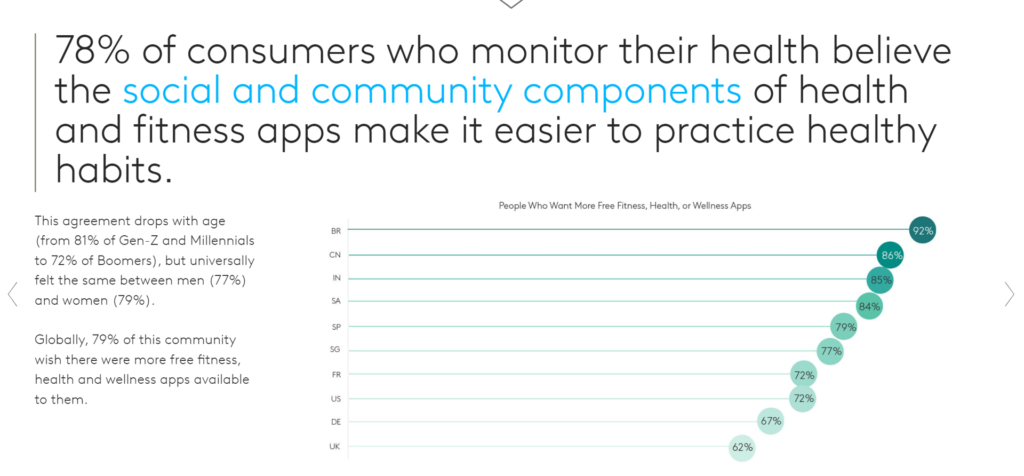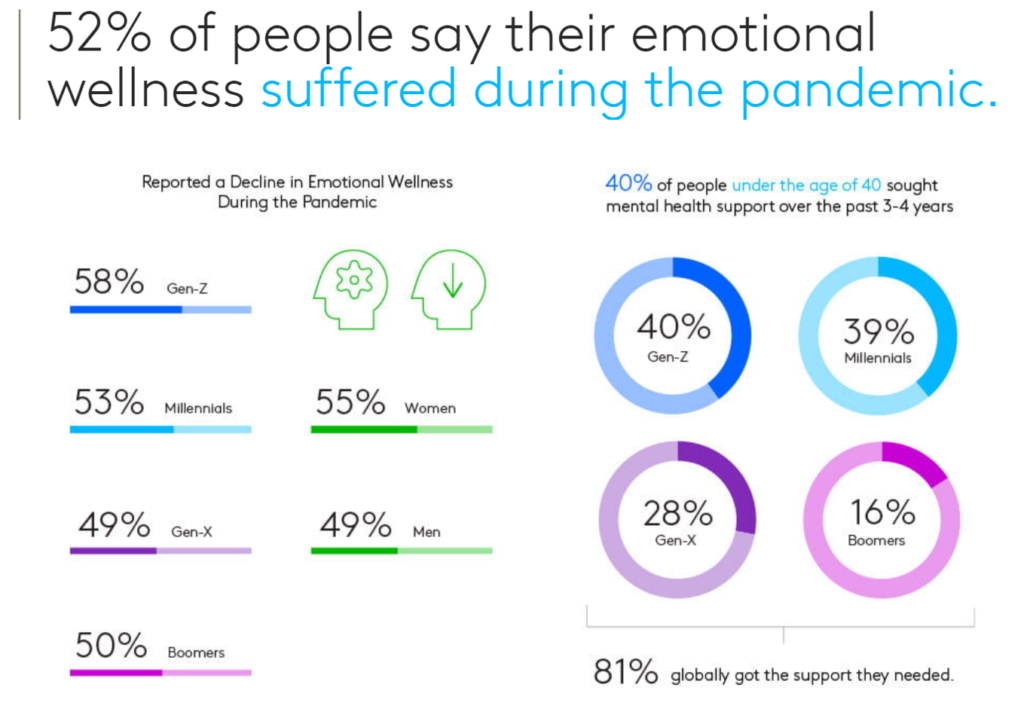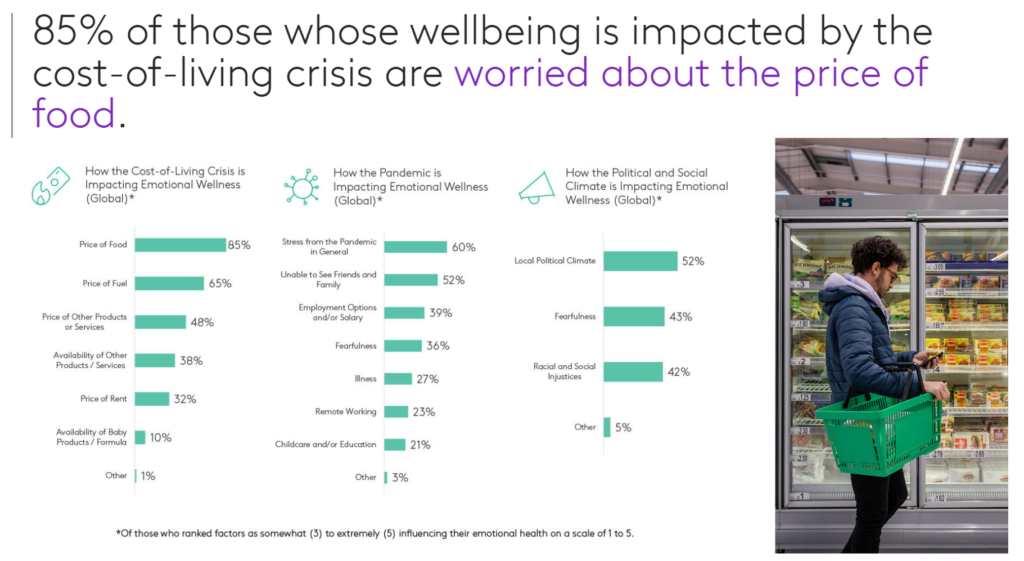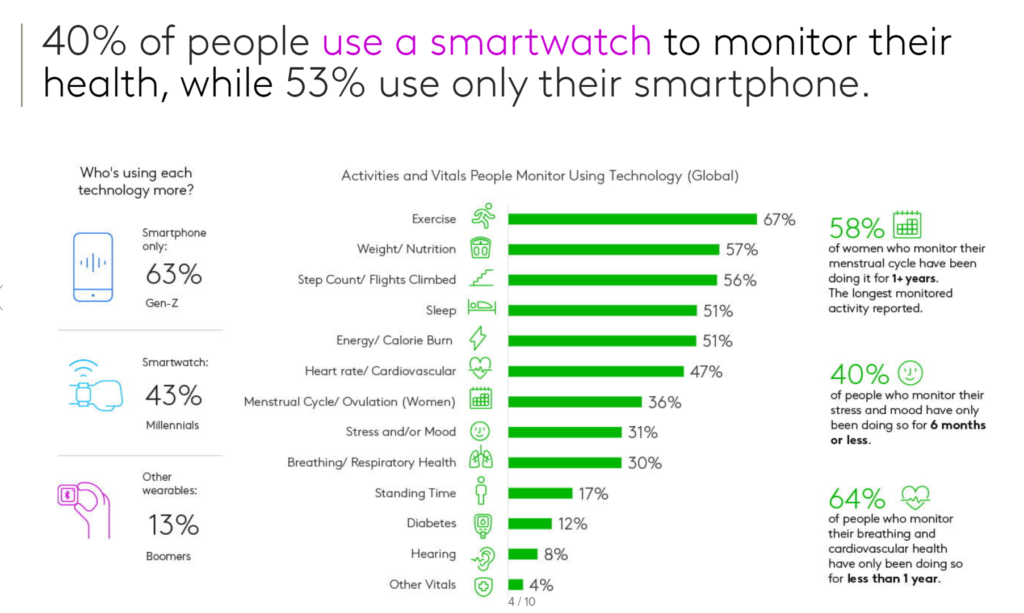People who need people aren’t just the luckiest people in the world: they derive greater benefits through monitoring their health via apps that make it easier to make healthy choices.
Channeling Barbra Streisand here to call out a key finding in new consumer research from Kantar on Connecting with the Health & Wellness Community.

Kantar polled 10,000 online consumers in ten countries to gain perspectives on health citizens’ physical and emotional health and the role of technology to bolster (or diminish) well-being. The nations surveyed included Brazil, China, France, Germany, India, Singapore, South Africa, Spain, the UK and the US.

The pandemic negatively impacted about one-half of all peoples’ emotional health across generations, with more younger people in Gen Z and Millennials feeling mental health stress along with more women than men.
On top of the pandemic-era stress impacts, in 2022 1 in 2 people also told Kantar that the cost-of-living increases have significantly worsened their emotional health than the pandemic did.
And specifically, the price of food and fuel have contributed to peoples’ fiscal stress impacts.

The political and social climate, as well, are impacting global citizens’ emotional wellness, shown at the right side of the third graphic here from Kantar’s report. Fearfulness and racial and social injustices are embedded in peoples’ wellbeing.

40% of people are using smartwatches to monitor health; 53% only use smartphones for health apps. Use of smartwatches for health tracking is highest among Millennials, and for smartphones-only among Gen Z consumers.
The most common activities and vitals that people monitor using digital tech are exercise (for two-thirds of users), weight and nutrition (57% overall), step counts (56%), sleep (51%), calorie burn (51%), and heart rate/cardiovascular tracking (47%).
Interestingly, while fewer Boomers are apt to use apps overall, those who pay for fitness apps have the strongest feelings about these apps: 40% say they can’t live without at least 1, versus about 1/3 of other (younger) health consumers.

Health Populi’s Hot Points: We learned through the great work of Christakis and Fowler in their book Connected (still a must-read for health care people, IMHO). The choices we make on a daily basis — to smoke or not to smoke, to binge drink or not, to be kind to one another, etc. — these behaviors kick on a virtuous or vicious cycle that influences our social network….and our network’s networks, fanning out virally.
The happy faces here come from one of the authors’ slide decks from their research, telling us that If You Wanna Be Happy, hang out with people who are….who are probably connected to other happy folks in their social networks.
Note that each unhappy friend decreases your likelihood of happiness by 7%.
The role of social and emotional health played a big part in this report on connecting with the health and wellness community.
Community is what too many health citizens are missing in the wake of the COVID-19 pandemic, current economic environment, and social-political chasms evident in many of the countries Kantar studied in addition to others not included in this research. In America, loneliness remains a legacy of the pandemic, further exacerbated by political and social schisms.

Kantar found that 39% of people saw improvements in their emotional health when they monitored their health with the support of technology. More granularly, that includes 44% of Gen Z consumers, and roughly 4 in 10 in the other generational cohorts.
Furthermore, 27% of people told Kantar that a fitness or exercise app made the biggest impact on their emotional health, shown in the last chart. In addition, 16% of smartwatch users pointed to that product making a positive impact on emotional health, and 15% using a meditation/mindfulness app helping to improve mental health.
Digital health apps, smartwatches and smartphones won’t be the panacea to solve our mental health crisis. But carefully curating well-designed and -intentioned technologies can and should certainly be one pillar in a multi-pronged approach to supporting health citizens’ emotional, mental, and social health and wellbeing.





 I am so grateful to Tom Lawry for asking me to pen the foreword for his book, Health Care Nation,
I am so grateful to Tom Lawry for asking me to pen the foreword for his book, Health Care Nation,  I love sharing perspectives on what's shaping the future of health care, and appreciate the opportunity to be collaborating once again with Duke Corporate Education and a global client on 6th May. We'll be addressing some key pillars to consider in scenario planning such as growing consumerism in health care, technology (from AI to telehealth), climate change, and trust -- the key enabler for health engagement or dis-engagement and mis-information. I'm grateful to be affiliated with the corporate education provider
I love sharing perspectives on what's shaping the future of health care, and appreciate the opportunity to be collaborating once again with Duke Corporate Education and a global client on 6th May. We'll be addressing some key pillars to consider in scenario planning such as growing consumerism in health care, technology (from AI to telehealth), climate change, and trust -- the key enabler for health engagement or dis-engagement and mis-information. I'm grateful to be affiliated with the corporate education provider  Thank you FeedSpot for
Thank you FeedSpot for